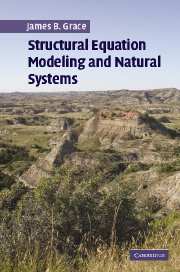Book contents
- Frontmatter
- Contents
- Preface
- Acknowledgments
- PART I A BEGINNING
- 1 Introduction
- 2 An example model with observed variables
- PART II BASIC PRINCIPLES OF STRUCTURAL EQUATION MODELING
- PART III ADVANCED TOPICS
- PART IV APPLICATIONS AND ILLUSTRATIONS
- PART V THE IMPLICATIONS OF STRUCTURAL EQUATION MODELING FOR THE STUDY OF NATURAL SYSTEMS
- Appendix I Example analyses
- References
- Index
2 - An example model with observed variables
Published online by Cambridge University Press: 04 December 2009
- Frontmatter
- Contents
- Preface
- Acknowledgments
- PART I A BEGINNING
- 1 Introduction
- 2 An example model with observed variables
- PART II BASIC PRINCIPLES OF STRUCTURAL EQUATION MODELING
- PART III ADVANCED TOPICS
- PART IV APPLICATIONS AND ILLUSTRATIONS
- PART V THE IMPLICATIONS OF STRUCTURAL EQUATION MODELING FOR THE STUDY OF NATURAL SYSTEMS
- Appendix I Example analyses
- References
- Index
Summary
In this chapter I present a simple illustration of a structural equation model. My purpose is to provide a concrete example of structural equation modeling (SEM) for the reader and to facilitate subsequent discussion. In this chapter, the emphasis is on illustrating SEM results and comparing those to the results achieved from univariate analyses. In subsequent chapters I will introduce the principles and procedures of structural equation models, which will shed further light on both the origin and interpretation of SEM results.
Background and univariate results
The plant leafy spurge, Euphorbia esula (Figure 2.1), is one of the most troublesome exotic species in North America. This species was accidentally introduced through multiple shipments of contaminated crop seed and has spread throughout the northern and central latitudes, causing substantial economic and ecological damage. Considerable effort has been spent testing and then releasing a number of biocontrol insect species, particularly in the genus Aphthona (the flea beetles).
The site that this example comes from is the Theodore Roosevelt National Park, which is a grassland preserve located in North Dakota, USA. From an initial infestation of 13 hectares in 1970, spurge populations have spread rapidly in the park. An aggressive biocontrol program was initiated in the 1980s. Since then, there have been more than 1800 releases and redistributions of populations of two flea beetle species, A. nigriscutis and A. lacertosa, as control agents for leafy spurge.
Information
- Type
- Chapter
- Information
- Structural Equation Modeling and Natural Systems , pp. 22 - 34Publisher: Cambridge University PressPrint publication year: 2006
